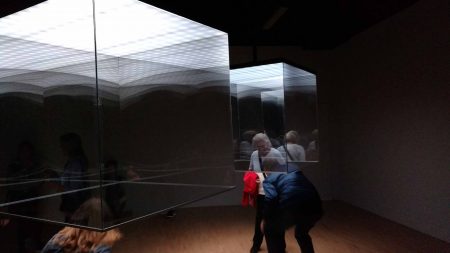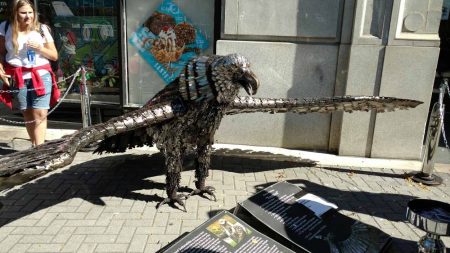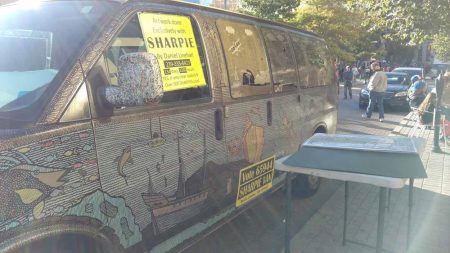Art fairs, biennials, and public art festivals, on the rise since the 1990s, define much of the post-1989 international art world. From Venice to New Orleans to Gwangju and everywhere in between, urban centers transform into art world Meccas and back again all over the globe, creating a map of flickering lights and a web of traveling artists and curators. Since 2009 Grand Rapids, Michigan welcomes its own quirky annual festival that both strives to enter into the international biennial game and actively challenges the art world’s standards for curatorial vision, art critical approval, and cultural prestige. While my trip to Grand Rapids felt quaint on the heels of a summer spent traveling to documenta, Skulptur Projekte Münster, and the Whitney and Venice Biennials, ArtPrize Nine did bring up a number of questions about taste, contemporary art, folk art, and populism that don’t often occur in major exhibitions.

Justin Langlois and Hiba Abdallah, Everything Is Happening Right Here, 2017. Installed next to Alexander Calder’s iconic public artwork, La Grande Vitesse (1969) in a plaza between government buildings that was one of the more empty spots during ArtPrize. Photo by Annie Dell’Aria.
ArtPrize began as a free, fully non-juried art festival with a major cash prize awarded by popular vote. Prizes by a jury of artists, critics, and other experts came the following year and after the grand prize went to a kitschy, photorealistic stained-glass image of the crucifixion in 2011, the top awards have been split, and equal prize money goes to popular vote and jurors’ selections. Rick DeVos, heir to the Amway Corporation fortune and son of current Secretary of Education Betsy DeVos, started the event to see how the public would engage with contemporary art. The event was initially largely bankrolled by money from the foundations of the DeVos family, who have been known to openly espouse conservative Christian ideologies within their direct-sales corporation, promote anti-gay marriage legislation within their state, advocate for so-called “school choice,” and donate millions of dollars to Republican political candidates. ArtPrize continues to receive funding by the DeVoses’ foundation, but is now a full non-profit entity largely funded through corporate sponsorship.
As an ostensibly radically open exhibition in a conservative town, one would predict a number of international artists and provocateurs would enter challenging work into the annual competition, especially given its origins in DeVos money, but not so fast. After submitting an artwork and paying the entry fee (currently $50 for individuals and $100 for teams), ArtPrize participants then have to secure a venue in the city, suggesting that there could be potential for hosts to decline works of art based on their political content and desire not to ruffle the feathers of the family whose name adorns numerous buildings and public places throughout downtown. Nevertheless, a number of artworks in ArtPrize Nine did not shy away from critiquing Donald Trump, his administration, and even Grand Rapids benefactor Betsy DeVos. These were almost entirely housed within curated shows rather than large exhibition halls or public spaces, something I came to realize as my day in Grand Rapids wore on and ArtPrize’s curious take on contemporary art became apparent.
A critics’ pick map directed me to some of the strongest exhibition spaces, clearly curated to contrast the relative free-for-all of some of the other venues I discuss below. Society of Spectacle, hosted by The Fed Galleries at Kendall College of Art and Design, featured works exploring our increasingly mediated social and phenomenological experience, including the interactive two-way mirror piece Two-Way Protocols by Zane Miller and the feminist sculpture and video projection Object Orientalis by Eva Rocha. The Urban Institute of Contemporary Art (UICA) featured “Cultivate,” an exhibition dedicated to food justice that also housed the video documentation of Juror’s Grand Prize winner Seitu Jones’s socially engaged project, The Heartland Community Meal.

E.J. Cobb performing Fixed It for You, a constant revising and critiquing of the words of 45, in the window of the Cerberus Studio venue. Photo by Annie Dell’Aria.
Grand Rapids Art Museum (GRAM), the city water building, and the small Cerasus Studio (not included in critics pick, but a happy discovery along the way) also featured some of the strongest pieces: Chris Vitiello performed one-line, made-to-order poetry in a quirky installation at GRAM; Jeffery Augustine Songco’s Society of 23’s Locker Dressing Room juxtaposed a sports locker room with a drag performer’s dressing room to explore American masculinity at the water building and won the Installation Juried Award; and E.J. Cobb furiously corrected and commented in red-marker over the speeches of Mrs. DeVos’s boss in Cerasus Studio. Fountain Street Church hosted some of the most politically provocative pieces including Three-Dimensional Juried Award winner Flint by Ti-Rock Moore, a water fountain spouting visibly dirty water with a “Colored” sign mounted above it. En route to see this show, however, I accidentally ended up at another church venue and instead saw kitschy landscapes, elaborately cut crystals, and a perfectly crafted wood boat worthy of Ron Swanson’s stamp of approval. This mix-up encapsulates the bizarre duality of ArtPrize, where a contemporary art festival and a folk art fire sale coexist and vie for the attention of regional tourists.
Having only one full day in Grand Rapids, I arrived early in the morning on a crisp Saturday in September. Prior to my discovery of the critics’ guide and before many of the museum and gallery venues opened, I meandered around downtown and stumbled across some of the public sculpture and entries in local businesses, which started to make me doubt the six-hour drive the day before. As I entered one of the venues actually open early, the Grand Rapids Police Department, I encountered a range of local artists engaged in a variety of mediums and crafting traditions with predictably conservative subject matter. The artists’ statements and frequently the artists themselves both here and at a number of other venues and outdoor locations encouraged viewers to vote for a work by stressing the very literal facts of its making. This one embroidered image of an owl took two months! This beaded wall hanging of a forest weighs a lot! This eagle took 500 hours of labor and hundreds of forks and knives! This van is covered with ink from over 500 Sharpies and 1260 hours of my time! This portrait of Lincoln took over 24,000 pennies and 315 hours! Incidentally the penny portrait of Abe took home $200,000 and the Public Vote Grand Prize.
This appeal to time spent and materials used in order to secure favored status in art seems strange in a contemporary context. I do not mean that there aren’t a number of labor-intensive works within more revered, curated venues for contemporary art—there are many, and indeed the equation of time-intensive projects and value was not limited to the folk art part of ArtPrize. Rena Detrixhe’s Dirt Red Monument, a delicate rendering of a carpet on the floor in dust alluding to the troubled relationship between humans and the land in Oklahoma, foregrounds its “200 gallons of sifted earth” and “200 hours of careful labor.” This piece won both the juried and popular vote prizes for time-based art, not one of the many video or film entries. In works like this and elsewhere in the contemporary art world the time or detail spent to finish the project is often conceptually folded into the work’s meaning rather than standing on its own as a signifier of value. In both instances the appeal of the artists at ArtPrize to time spent reminded me of a famous vignette from art history that I have my students reenact in the classroom: James Abbott McNeill Whistler’s trial against the critic John Ruskin. When Ruskin wrote that Whistler’s 1875 painting Nocturne in Black and Gold—The Falling Rocket was eccentric, poorly executed, and even “flung a pot of paint in the public’s face,” the artist sued him for libel. Though Whistler won, he was only awarded a farthing, but the trial itself is a telling look at nineteenth-century debates around art, labor, abstraction, and money. One of the many memorable exchanges from the rowdy trial reads as follows:
Did it take you much time to paint the ‘Nocturne in Black and Gold,’ how soon did you knock it off? (Laughter.) – I knocked it off possibly in a couple of days—one day to do the work, and another to finish it.
And that was the labour for which you asked 200 guineas? – No; it was for the knowledge gained through a lifetime. (Applause.)
The two simultaneous art experiences that coalesce at ArtPrize could be actually contemporary in the truest sense of the word—“con” and “tempus” or “together/with” and “time”—connoting separate things happening at the same time across borders of taste in a similar way that international biennials demonstrate contemporaneity across physical borders. However, returning my initial discussion of the corporate and political threads wound into this event’s origins and location, I believe some level of critical awareness is necessary. On the one hand, ArtPrize uses the immense wealth of the DeVos family and other corporations to offer exposure and a wide variety of seed grants and prize money to emerging artists and get a lot of people to come together and see art. Art history is full of generous benefactors whose politics and business dealings were at best unsavory and at worst immoral from the Medicis to the Rockefellers and now the Sacklers. In this economic climate, I’m all for artists taking corporate money and using it to make their own work as long as there are no strings attached, though we should not forget that nearly all participating artists travel to Grand Rapids, insure, install, and de-install their work completely on their own dime. I am also entirely in favor of events that get the public engaged in contemporary art for free, something that I think is ArtPrize’s biggest contribution to both the region and the national art scene. On the other hand, ArtPrize’s populist leveling of artistic production, its frequent foregrounding physical toil and material labor as grounds for artistic value, and its problematic implied narratives of self-funded, bootstrap, American Idol-type artistic success should not be ignored.
–Annie Dell’Aria






